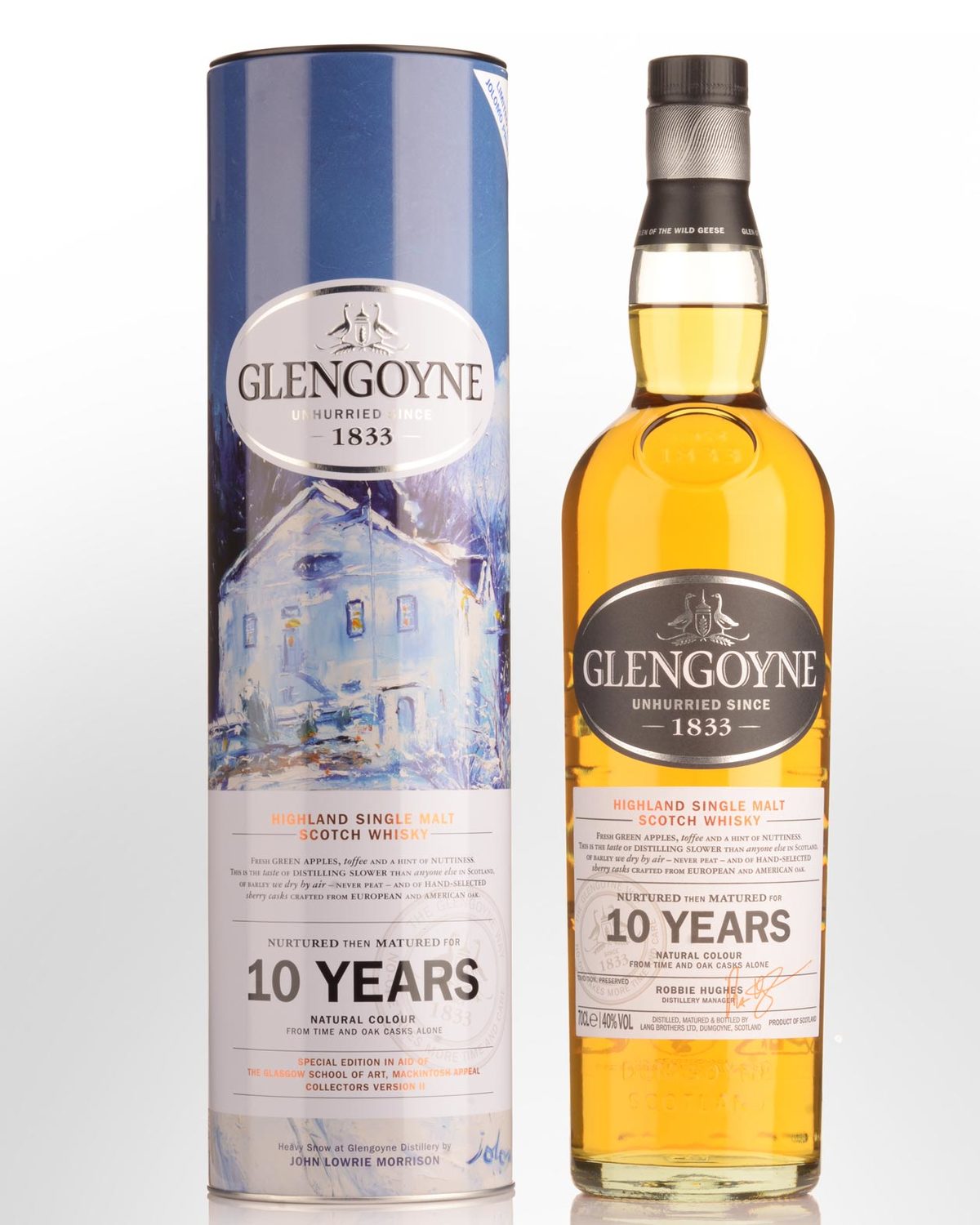
- 90
- Nick's Import
- Reduced
Glengoyne 10 Year Old Jolomo Limited Edition Single Malt Scotch Whisky (700ml)
Note: These may have dented tins. The bottles are undamaged.
Number three in a series for Glengoyne. The packaging features the painting ‘Spring Blossoms at Glengoyne Distillery’ by John Lowrie Morrison (aka Jolomo). Also comes with a print of the painting inside the tin.
A while back we offered a ridiculous deal on a whisky rarity - Macallan 12 Year Old 100% Sherry wood. Here’s another distillery producing a ‘sister style’ in the South - ‘Glengoyne’. Although geographically removed, they’ve built their reputations on identical points. Firstly, both air dry their malted barley rather than dry it over a peat fire. Secondly, they’re very particular about barley selection. Barley is the reason why malt whisky tends to taste 'better' than other kinds of whisky. Quite simply, it contributes more flavour than most other cereals (rye is the exception here). If you've ever tasted a grain whisky made mainly from maize or some other grain like wheat, you'll have noticed they're much more lightly flavoured. (Seek out ‘Cameron Brig Grain’ or ‘Greenore Single Grain’ on this site for some good examples of what we’re talking about).
The question of which barley makes for a better whisky remains contentious. Within the industry some still maintain the only thing that’s required from the grain is that a good amount of fermentable sugar is obtainable after malting. At the same time, Grand Marques like Macallan have built their reputation during the early 1980s and ‘90s in large part by emphasising hardline traditional practises - 100% Sherry maturation and a predominant use of a special variety of barley called “Golden Promise”. In fact, they released a 50 Year Old (one of their most expensive whiskies) made exclusively with Golden Promise. This dunce performer of the barley world is relatively low yielding and disease-prone enough for most farmers to have happily forgotten about, yet in the Scotch whisky world, it’s traditionally been highly prized for its rich, nutty flavour. As production has expanded at Macallan, they’ve surreptitiously surrendered the fact that since 1994 Golden Promise constitutes no more than 30% of their mash bill. Purists should note - if Macallan last used its original ratio of Golden Promise barley in 1993, then our current stocks of 18 year old (distilled pre 1992) will be near the last made from the same. The taste of ‘true’ Macallan may not be had for much longer at any price.
OR you could simply buy Glengoyne for a fraction of the cost.
It is now the only distillery that continues to use majority Golden Promise and one of a dwindling few to completely avoid peat. The resulting whisky lets the purity of the barley take centre stage, positioning Glengoyne firmly at one end of the malt whisky spectrum - relatively light bodied, but with surprising depth and a trademark grassy / fruity interplay that’s a delight. The house style coincides with a close proximity to famous Lowland distilleries like Rosebank and Littlemill, yet Glengoyne's labelled as a Highland - not out of choice, rather it’s part of new regulations imposed by the Scotch Whisky Assosciation. Glengoyne’s Scott Hendry comments: “We are in the Highland camp and must remain so, but to be honest, being a Lowland isn't something that I'd see as a negative, given how cluttered the Highland category is we'd probably achieve better stand-out if we were a Lowland (and no, this isn't the start of a campaign to change our classification, we're staying put!)'
All Glengoyne’s whiskies are filled into Sherry and Bourbon casks and matured on site. No colouring is added.
Tasting note: Bright gold colour. A delightfully clean bouquet leads through aromas of nutty cereals, lucerne hay and suggestions of unripe pear, becoming more salient with aeration. Light to medium bodied, the palate offers good concentration. Semi sweet, pristine, chewy malt combines with delicate spices before seamlessly dovetailing into a light, dry finish with the spices lingering. Hints of dried grass and vanilla follow with remarkable persistence before a surprisingly late cocoa fade. Stylistically, this is rare in the whisky world in that it delivers lightness of body combined with depth of flavour. And yes, after malting, milling, mashing, fermentation, distillation and barrel-aging, the flavour of the barley per se really is distinguishable. Putting this against a lightly peated Speysider would be an interesting cross tasting that makes a point. 40% Alc./Vol.
to most of Australia
